Is the idea that this a Roman tomb still floated, or is it certain that it is Macedonian?
Largest ancient tomb found of a prominent Macedonian
Collapse
X
-
I couldn't find an English text, so this is an extended interview (Google translated) of Palagia, arguing it is likely a Roman tomb or monument.
-----------------------------------------------------------------
My opinion is that the finding of Amphipolis is more important than what we believe at this time the excavators "argues Professor of Classical Archaeology at the University of Athens Olga Palaggia depositing in" Dawn "hypothesis for the monument dating to the Roman period. Instruction in this case the study of the sculpture of the monument, mostly of the Caryatids, while linking the monument to the battle of Philippi.
A basic assumption of the Professor of Classical Archaeology
Professor of Classical Archaeology at the University of Athens in ancient sculpture specialist, Mrs. Palaggia has published numerous studies on ancient sculpture, including the Roman Caryatids, the sculptures and art of ancient Macedonia. He has a Ph.D. from Oxford University and has participated in many international conferences announcements. He has written monograph including the pediments of the Parthenon and has edited several collective volumes as to the technique of ancient sculpture, the art of Athens during the Peloponnesian War and the Macedonian domination of Athens during the 4th and 3rd century BC. Ch.
The "Dawn" captures the working assumption of eminent international archaeologist, however, awaits with interest the results of the excavation itself.
Interview with Polly Krimnioti
* What is your opinion about this finding?
H is my opinion that the finding of Amphipolis is more important than what we believe at this time the excavators.
* What do you mean?
It is of global concern because it may be associated with the battle of Philippi. In 42 BC Philippi clashed two large Roman armies, one of the army of Brutus and Cassius, the murderers of Julius Caesar, and the other of Mark Antony and Octavian, nephew and heir of Caesar. It is a civil war that changed the entire course of the ancient world. If you had defeated Brutus would not have established the Roman Empire. Because it was a civil war, and the two sides fought relatives and friends, members of the Roman aristocracy.
Brutus and Cassius were defeated and committed suicide and we know that Brutus was honored by his opponents after his death. Octavian, winner s because he did not want to continue the discord between the opposing parties, tried to appease opponents. These are historical facts. It is also historical evidence that the camp of Mark Antony and Octavian were Amphipolis. The camp of Brutus and Cassius were in Kavala, while the treasury of guarding Thassos. We know from history that after the defeat of Brutus Mark Antony went to Thassos and took the treasure of the dead, now, democratic opponents.
* How do you connect the battle of Philippi to Amphipolis monument?
The archaeological excavation data we know through the official bulletin of the Ministry of Culture and the photographic documentation and design representation of the entrance of the monument, which was also made public by the Ministry, we observe that the entrance of the monument consists of a vaulted corridor. Until now they have excavated two marble sculptures with propyla, the sphinxes and caryatids.
It seems according to official announcements, that the doors were not leafs. What is striking is also widely used in Thassos marble monument and indeed the revetment wall. Marble is generally not been used in Macedonian architecture, although we use the sculpture as the Lion of Amphipolis. And the Macedonian tombs have marble door panels, which was not Thassos marble. In archeology rely on parallel and so far, to my knowledge, we use Thassos marble architecture of classical and Hellenistic Macedonia.
The Caryatids think that somehow "lock" the dating of the monument to the Roman era. It archaistic, that mimic the archaic Daughters of the Acropolis. Oblique wear garment Maidens archaic and archaistic also clean tunic, which was originated by the sculptor. On the other hand, the figure refers to the classical period and the hairstyle is a combination of late Classical wavy curls, but they fall on the shoulders rotating forming strands, which are known from Roman sculpture. That witnessing Caryatids a stylistic hodgepodge that we do not refer to the time of Alexander the Great and his successors, but much later.
* You are specialized in sculpture. For the Roman Caryatids have published studies. But in this case how do you document that the Caryatids of Amphipolis dating to Roman and not the Macedonian period?
Because no such Caryatids archaistic in monumental sculpture before the mid-1st century BC The oldest example is the Caryatids small Propylaea at Eleusis erected by the Roman deionized Claudius Pulcher (Appius Claudius Pulcher) around 48 BC Latin dedicatory inscription preserved. I am surprised if the Caryatids of Amphipolis was actually the 4th century. BC, why not reappear Caryatids similar to the 1st century. BC .; In art, an invention after repeated.
* The same case for you and the Sphinx?
Yes, because the Sphinx is monumental, two meters high. But the period of Phidias, ie classical period to the 1st century BC we have the monumental sculpture Sphinxes. We statuettes Sphinxes as accessories thrones Egyptian Sphinxes and small type tombs of Alexandria. Amphipolis monumental Sphinxes these are classical form and refer to the symbol of Octavian, which is used to seal and currency. Morphologically Sphinxes Octavian resemble Sphinxes of Amphipolis.
* How are you sure because it is damaged wings and head?
The body is the same. So we do the assumption that Octavian put the symbol in porch.
* The sphinxes and caryatids is enough information to substantiate your view that the monument dates back to Amphipolis in Roman times?
Yes, it is capable of. In addition, however, the typology of the Macedonian tombs are not consistent with our present findings of the tomb monument caste unveils the Ministry of Culture. The entrance to the tomb caste consists of a long narrow arched hallway with three successive propyla. Instead, the Macedonian tombs usually consist of an antechamber and a main chamber, ie have runways propyla.
To dated monument of Amphipolis in the period of the Macedonian tombs should have pottery or coins or inscriptions. So far, however, has not presented any of this. I also want to point out the similarity of the Tomb castes with the Mausoleum of Octavian (later August) in Rome. The mausoleum was built around 28 BC and the form of the Tomb where the soil retained by masonry.
At the top of the monument was, in this case statue of Augustus. The burial chamber was inside the Tomb, was reached by a vaulted corridor, which is reminiscent of the vaulted hallway of Amphipolis. Inside the burial chamber of Rome was placed the bones of August and twelve members of his family, together with Latin inscriptions.
* Why do you think the Prime Minister is talking about Hellenism of Macedonia?
The Hellenism of Macedonia is given, and has been shown not expect even a monument to our confirmed something that has already been established. Apparently the Prime Minister believed that the monument would contain gold offerings in proportion to the golden Vergina. The Ministry of Culture probably misled by morphological similarities of architecture finding Amphipolis architecture of Macedonian tombs, such as the mosaic with diamonds found outside the entrance to the memorial, which refers to a similar mosaic of a Macedonian tomb of Amphipolis located at the Museum of Amphipolis. But the vaulted structure refers to Macedonian tombs.
Also the correlation of the Lion of Amphipolis to the top of the Tomb of caste, although that has not been generally accepted, I think that swept the excavators date the monument at the same time with Leo, at the end of the 4th century BC And I say this because the excavators had to study the correlation of the Lion of Amphipolis to the top of the Tomb at a conference held last year in Thessaloniki, before even discovered the entrance to the monument. By always the official bulletin of the Ministry and photos published, and we have another element that makes us assume that this imitation of Roman architecture Macedonian tombs. And I mean the fact that the coloring of Ionic pilasters was plastered and not directly on the marble.
In Macedonian tombs, which usually is not used marble, the colors were plastered. Also there is a ramp with superimposed propyla refers not to the architecture of the Macedonian tombs.
* Do you think that the monument is looted?
Yes, it is looted, as the wings of the Sphinxes damaged and missing their heads. It has also destroyed the head of a Caryatid. All losses made by human hand.
* Looters, as written?
I do not think that is from looters. We know that Amphipolis was destroyed by a large Thracian raid the 1st century BC It was worth it to detect if the monument was destroyed by the Thracians then, so it was then sealed by the Romans. I believe that propyla testify that the monument was originally designed to be accessible to visitors.
* What kind of monument you think is the tomb or something else?
The similarities with the Mausoleum of Octavian Augustus, the Roman dating Caryatids and the shocking fact of the battle of Philippi in the area allow us to formulate the hypothesis that this monument victory of Octavian and Mark Antony, in conjunction with polyandrion for Romans fallen officers and the two factions.
* The scientific community thinks that the Prime Minister, the Ministry of Culture, Media anticipates portion of scientific communications for the Dig. You as a scientist because outrun?
Because I do not want to be accused of that, and I outrun, I formulated a hypothesis Drawing on the one hand of the Roman dating of the Caryatids on the other the great historical event of the battle of Philippi, which might justify a colossal monument. I remind you that the Romans were distinguished for the colossal monuments and technical works. Unlike the monuments of classical and Hellenistic Macedonia is a much smaller scale.
* All this publicity for the excavation of Amphipolis helps the monument and archaeological research;
Certainly not, because it anticipates conclusions and creates pressure mainly on excavators. It also creates expectations in public, and which may be disappointed. Scientific research must be carried away by the hype. One of the reasons that I speak today not to confront my colleagues but because I want to understand that the political and media pressure around an excavation does not help in detecting the truth.
Comment
-
-
Did British soldiers plunder Amphipolis Tomb in 1916?
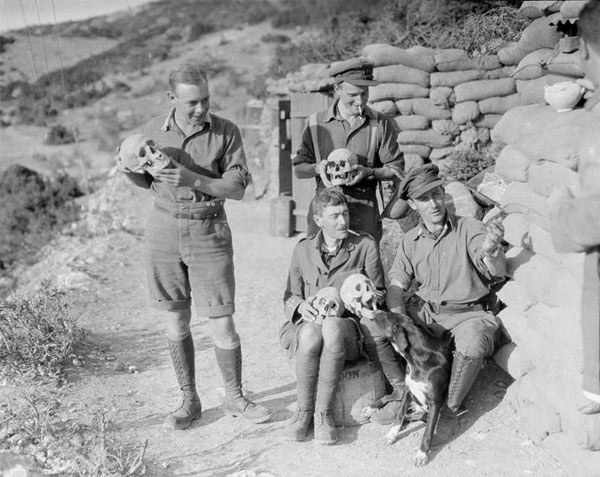 A photograph has emerged depicting soldiers from a regiment of the British Army, proudly holding skulls found around the Amphipolis Tomb in Greece, raising questions about whether they may have plunde
A photograph has emerged depicting soldiers from a regiment of the British Army, proudly holding skulls found around the Amphipolis Tomb in Greece, raising questions about whether they may have plunde
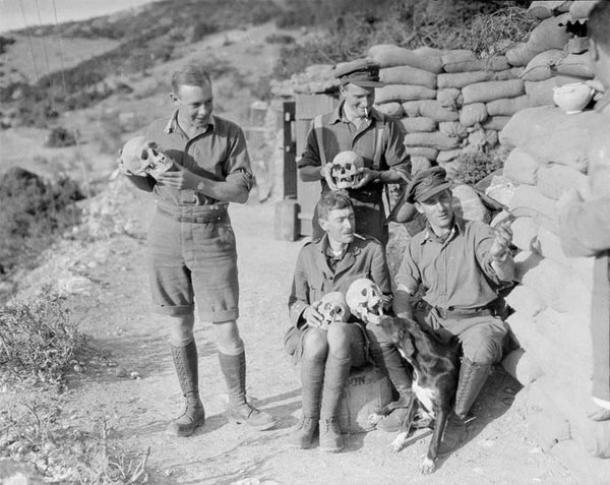
A photograph has emerged depicting soldiers from a regiment of the British Army, proudly holding skulls found around the Amphipolis Tomb in Greece, raising questions about whether they may have plundered the tomb nearly a century ago.
The King's Shropshire Light Infantry (KSLI), a regiment of the British Army formed in 1881, was posted to Thessalonika in Greece in 1915 at the request of the Greek Prime Minister and spent nearly three years fighting the Bulgarians in Macedonia. For the most part, they were based on the Struma front between Lake Doiran and Amphipolis, where they constructed trenches and dugouts and fought numerous skirmishes. However, it seems the battalion did more than just fighting, as photographs have emerged showing evidence of the soldiers entering the famous tomb at Amphipolis, as well as proudly showing off human remains found at the site.
It is already known that the spectacular Lion of Amphipolis, a 5.3 metre-high marble statue that once stood on top of the giant tomb of Amphipolis, was found by British soldiers who were building fortifications at the bridge of Amphipolis in 1916. The British tried to smuggle the marble parts to England, but their efforts were thwarted when Bulgarians who had just seized Paggaion attacked them. Archaeologist Fotis Petsas, whose work on the history of the Lion of Amphipolis was published in 1976 in "Proodos" newspaper that circulated in Serres, wrote:
"During the Balkan War in 1913, Greek soldiers found the foundations of the pedestal of the monument while digging trenches. The foundations were examined by George Ikonomos and Anastasios Orlandos who subsequently became professors of archaeology. Later, in 1916, during World War I, British soldiers discovered the first parts of the marble lion. Their attempt to transport the pieces onboard a ship were thwarted by an enemy bombing."
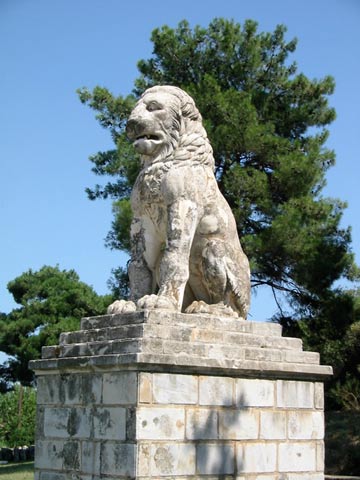
The marble statue of the Lion of Amphipolis. Image source: Wikipedia
When archaeologists entered the second chamber of the Amphipolis tomb last month, they found that the marble wall sealing off the third chamber had already been smashed open in one corner, leading researchers to believe that the tomb may have been looted in antiquity. However, the plundering may not have occurred in the ancient past, but by the British soldiers in WWI.
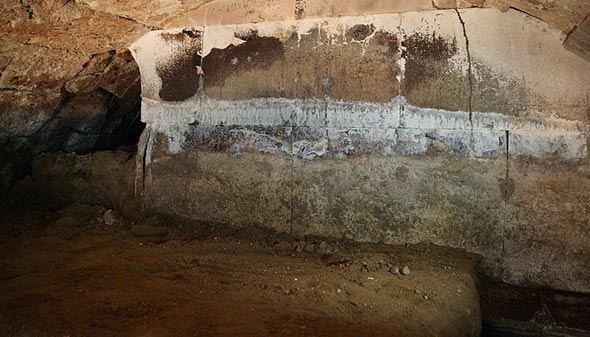
When archaeologists entered the second chamber, they discovered that the wall sealing off the third chamber had been smashed in one corner. Credit: Greek Ministry of Culture
A little digging around on the website of the British Museum has revealed a little more to the story. The biography page for Dr Eric Gardner (1877 – 1951), a British medic and amateur archaeologist, who was posted to Greece during WWI, reveals that he took treasures found at Amphipolis and ‘donated’ them to the British Museum. The British Museum writes: “He was based around Amphipolis on the Struma front, where an Archaic-Hellenistic Greek cemetery was uncovered. Donated contents of an Amphipolis grave to the Museum in 1918.” So was this ‘Amphipolis grave’ the great tomb that is currently being excavated by archaeologists?
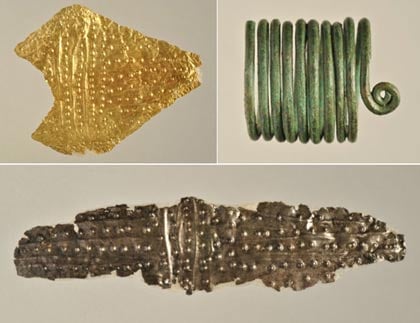
Top Left: Gold mouth piece with repoussť decoration. Top Right: Bronze spiral finger-ring. Bottom: Silver plaque with dotted repoussť decoration. All excavated from Amphipolis grave, 6th century BC. Given to British Museum by Dr Eric Gardner in 1918. Photo Credit: Trustees of the British Museum
Within the grave, Dr Gardner found a hoard of treasures including gold, silver, and bronze jewellery, finely crafted pottery, a metal hair pin, an iron knife, and a spearhead. It is not known how much he kept for himself, but nine of these items now sit inside the British Museum in London. It is curious to say the least, that in the midst of the media frenzy regarding the current excavation of the enormous tomb at Amphipolis, the British Museum has remained deafly silent on the issue. Perhaps they are afraid of another ‘Elgin Marbles’ scenario in which the world petitions them to return stolen goods to their origin.
Featured image: Officers of the 2nd King's Shropshire Light Infantry with skulls excavated during the construction of trenches and dugouts at the ancient Greek site of Amphipolis, 1916. Image source: Ministry of Information First World War Official CollectionThe Macedonians originates it, the Bulgarians imitate it and the Greeks exploit it!
Comment
-
-
We're all held to account hereOriginally posted by Tomche Makedonche View PostTalk about putting me on the spot, but I think I managed to find it
 Thanks for chasing it up.
Thanks for chasing it up.
I still think (or perhaps hope) it is more likely that the tomb is of some Macedonian noble. But at this point it is obviously speculation.I’d be interested to know what your educated guess would be though, if it is a tomb post Aleksandar III, who would you consider are the likely candidates?In the name of the blood and the sun, the dagger and the gun, Christ protect this soldier, a lion and a Macedonian.
Comment
-
-
That's not true, but what is this?Originally posted by The LION will ROAR View PostHowever, it seems the battalion did more than just fighting, as photographs have emerged showing evidence of the soldiers entering the famous tomb at Amphipolis, ...
 Aut viam inveniam aut faciam - Ή θα τον βρούμε το δρόμο ή θα τον φτιάξουμε
Aut viam inveniam aut faciam - Ή θα τον βρούμε το δρόμο ή θα τον φτιάξουμε
It seems similar, yet different but I couldn't locate the source of the picture or the country (see two pictures [around No 25-27 starting from top] of English soldiers trying to enter in a similar sealed tomb).
You will have to scroll a lot but it's woth it!!!
One of the two photos is also here (compared to Amphipolis tomb):
====Last edited by Amphipolis; 09-24-2014, 07:41 AM.
Comment
-
-
New press release and pictures (google translation)
Continued from KH Ephorate of Prehistoric and Classical Antiquities, archaeological research in the funerary complex caste hill Amphipolis. Removed the last two domes of the sealing wall in front of the second septal wall, revealing a whole marble pedestals upon which tread the Caryatids.
The decoration of the piers is a continuation of the marble revetment walls. It consists of marble blocks with peritainia. The height of the pedestals is 1.40., Width 1,36m. 0,72m and thickness. The total height of the statue and pedestal is 3,67m .. The second floor is elevated by 0.07 M. Trace blue color detected in front of the upper surface.
Continued also the excavations on the site behind the Caryatids, by removing soil to a depth of 1.5m. revealing the continuity of the marble revetment walls, as in the previous room, and a large part of the doorway that leads to the third space.
Completed, yet Work supports adding columns in the first place and also placed second in the horizontal struts to proceed apochomatosi. Furthermore, with continued apochomatosis in doorway third diaphragm wall, work began shoring third space.
Check the link for pictures
I should notice that:
(a) This is too high and impressive and reminds us what it takes to remove (slowly and carefully) soil higher than 4m in each chamber of a room about 6m*4m.
(b) Now that the sealing wall has been removed, there's no wall at the Caryatides, so basically there's no First and Second Chamber, as we conventially used to say. The Caryatides are there in the middle of a "hallway".
==Last edited by Amphipolis; 09-30-2014, 12:32 PM.
Comment
-
-
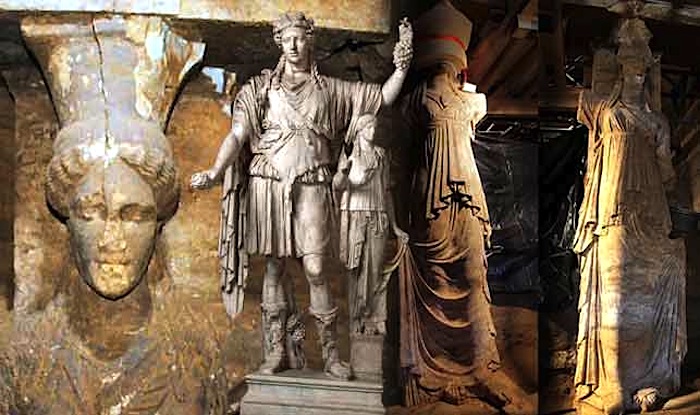 By Andrew Chugg* I wrote my initial article on this question on the morning of 6th September (a day before the announcement of the discovery of the caryatids) and I wrote a second part, dealing with the caryatids and a few other issues on 20th September. In these two articles I drew a number of […]
By Andrew Chugg* I wrote my initial article on this question on the morning of 6th September (a day before the announcement of the discovery of the caryatids) and I wrote a second part, dealing with the caryatids and a few other issues on 20th September. In these two articles I drew a number of […]
....."the occupant of the Amphipolis tomb is most likely to be Olympias or else possibly another important queen of Macedon.""The moral revolution - the revolution of the mind, heart and soul of an enslaved people, is our greatest task."__________________Gotse Delchev
Comment
-
-
Leaks (not official, google translation):
After removing soil, three fragments of a marble door are revealed in the third chamber. Made of Thassos marble as the rest of the finds in the tomb and according to archaeologists it shows that most certainly we're talking about a grave. This seems now as a typical Macedonian tomb.
Also the hinge of the door was found.
In the soil of third chamber bronze and iron nails were found.
Edit: The marble door is broken and behind it there a staircase leading to a level 2m lower.
==Last edited by Amphipolis; 10-02-2014, 07:36 AM.
Comment
-
-
Official Press release, video, pictures and interview here:

Google translation
With today's announcements from Amphipolis shot down one of the main arguments of archaeologists question the periodization Macedonian Tomb Caste: The marble door panels revealed during the removal of embankments show that a) is a funerary monument and b) dates from the 4th c. Ch. century and may even be described as 'typical form Macedonian tomb'.
Typical is on this statement of chief anaskafeos, Mrs Katerina Peristeri: "The door we found reinforces our view that this is a grave. We have a fantastic funerary complex, which belongs to the last quarter of the 4th century BC. "
Part of the marble door with decoration lentigines (nail heads, imitation wood door)
However, the door panels were found broken, which raises new questions as to the cause of the fracture. How and why it broke? Is this another sign of attempted penetration by grave robbers? And if so, how far reaching since broke the doors of the third chamber? Of course, the answer to these questions requires a representation of the type of seal in the concrete wall.
Graphical representation of the doorway in the third septal wall, with the door panels and found broken rotors
However, the two door panels are made from known Thassian, white marble, width 1.5 meters and 14 centimeters thick. Just like they were made of wood, the door panels with decorative fake nails (lentigines, ie the "heads" of the nail). On the west side of the doorway was also pivot, ie one of the support mechanisms ("sag") of the hinged door hinge -commonly. The opening of the third doorway, that the marble Ionic doorframes are slightly less than the previous two (Sphinxes, caryatids) as the opening is 1.5 m. Instead of 1.67 m. The first two. Behind the Caryatids and just in front of the door were found bronze and iron nails. Although the immediate connotation is "coffin (stretcher) dead", archaeologists do not rush to identify the nails as such. Currently, the origin and use of the starch is unknown. On the level of the third and fourth chamber, which in the conjectures of archaeologists and attempt sounding specific geologist, is larger than the previous space, the current update does not reveal any new evidence. Nevertheless, the impression is that the memorial grows downward strengthened, as the team of experts considers that the fourth floor of the chamber is about two feet deeper than the previous. As is obvious, after the doorframe of the third diaphragm wall should be some kind of downward passage configured access steps or ramp (ramp).
Work shore up the vaulted ceiling continues, based on the "passive" support logic, namely the containment of possible displacements
The entire transcript of the briefing held at the Museum of Amphipolis by the head of archaeologists Katerina pigeons, the general secretary of the Ministry of Culture and Lina Mendoni journalist Anna Panagiotarea, and the transcript of the question and answer session with journalists attending as follows:
1 With the removal of soil, yesterday revealed sections of marble door, the typical form of the Macedonian tombs: So, we made port of Aliki Thasou- as marble is made and the entire burial sygkrotima- with lentigines, which mimic the head nails, as befits the wooden doors. (photo 1).
2 On the western side of the doorway is found to exist hinge. The pivot point is the hanging of the door jambs. (photo 2 project).
3 We remind the size of openings: Openings Caryatids and Sphinxes exactly 1,67m. The opening of the third doorway is 1.50m.
4 During the excavation revealed the continuity of the side walls, which is no different from previous sites, namely marble slabs, similar to that present in all areas of the monument.
5 During the excavation also found in front of the door, behind the Caryatids, bronze and iron nails. We stress that yesterday and found not a given that "mentioning a stretcher."
I also want to make two general observations:
1 As I read in press reports, there is speculation that the archaeological investigation in accordance with the excavation process, ie, removal of excavated layers in a systematic way, as is clear from the diaries of the excavation, it is clear that the work done in the most appropriate scientific manner.
2 On how removing the soil from the excavation through the grave, note the following: In order to facilitate the excavation and proceed as best possible and safest used conveyor earth, as indeed customary and other excavations .
Technical work:
1.The floor of the backfill behind the Caryatids has arrived as the coronation of the pedestals on which are based the Caryatids, which is about 1.5 m.
2 This embankment will remain provisionally retaining the third aperture. Will start to be lowered in combination with the removal of soil from the fourth space.
3 Please note that space, ie, behind the Caryatids as the third septal wall, placed second phase elements, with strong Metal hollow sections.
4 Also, the broken temporarily ypostilothike transom of the third diaphragm, which will be removed to clean and maintain.
5 In fourth place -who characterized by continuous revetment same type Aliki Thassos marble, like the whole mnimeiou- implemented since the second job of retaining walls and shoring of the dome for the safety of workers and the monument. It has therefore been concluded that retaining the coronation of the side walls and has begun the installation of shoring the dome with metal tubular beams.
6 Because of the delicate balance in which the canopy, technical consultants along with the crew trying, with delicate operations to place the prop without disrupting the balance that is created after the external apochomatoseis.
7 Please note that the prop has been implemented in two thirds of the surface of the dome. The outer embankments located there allow you to develop safer process of shoring. (photo 3.4).
8. shore up used is "passive" ie, activated only in cases where an voussoirs tends to move-which ensures minimal impact on the existing balance of the dome.
9 You will understand that we are in the hardest part of the work so far carried out for the safety of workers and the monument.
10 I have said that the embankment is sloped from south to north, with a height difference of over a meter. In the fourth septal wall opening is detected, which have also been reported in greater depth than previous openings. Technical leads to the conclusion that the floor of the fourth area is deeper than the floor of the previous properties, possibly by two meters.
11 Normally, this indicates the existence of stair or ramp which probably begins after the doorframe of the third aperture.
12 Supplementary report that has advanced the earthmoving work done on the west side of the monument for lowering the amount and soften the gradient slope.
question and answer
Question: There is much debate that the monument was known. Why did you decide to dig a well known monument?
Reply K.Peristeri: Great mistake. We started in 2012 with the excavation of the enclosure, matching the lion on top of the mound and continued to the grave. Showing speaking people who worked in forty years had no idea about this monument.
Question: Is there a schedule of when it has been revealed only 5% of the monument?
Reply K.Peristeri Very roughly put. The excavation will answer.
Question: After the new findings with nails and pieces of the door, reinforced dating?
K.Peristeri Answer: When we date the monument to the last quarter of the 4th century BC, are absolute certainty for both the enclosure and for our findings. The coming gentlemen, that a photograph dating, does not. The nails are not enrich dating. We give you all the information to get a clear picture. However, not all the material coming out in a press release.
Question: From August onwards, were new gaioskanarismata?
K.Peristeri Answer: There have never been there to dig now. There was rubble and Lazaridis have been impossible. It has become the natural hill, where tombs Iron Age and archaic.
Question: There has been doing similar research Koukoulis lady?
K.Peristeri Answer: I do not know what he has done. I do not have to file anything relevant Inspectorate. What says Mrs. Polymenakos not valid. He came in 1992 and did research at the tomb of the fox and the surrounding Macedonian tombs.
Question: There are reports that say that participants in the policy process operators.
Reply K.Peristeri: Not something happens tetoio.Kano excavations over 30 years. I feel adoration for my job. All these are vices. Unless you mean that I support provides the political leadership of the subgroups in which I serve and I thank them for that.
Question: What do you say lady Mendoni?
Answer: I do not understand why we are talking about political exploitation. Led to finding someone to be there found? Why is political ekmtallefsi because the Culture Minister visits finding exercise of the powers of? Since when is political exploitation, the fact that the Prime Minister of interesting visits an important monument?
Question: The evolution of the excavation confirms your case for Macedonian tomb. At the same time telling us that found fallen marbles. Sounds of architects that apochomatosi hurt marbles.
K.Peristeri Answer: We did apochomatosi with machines over the grave. But here in 1913 there was a Bulgarian army unit and given battles. I still find shells, possibly causing damage. While the 6th century AD, had 6.8 Richter earthquake that changed the runes of Strymon, causing also damage and grave.
Question: They have come to the tomb?
Answer: C.. Peristeri: In ancient times might have been robbers enter. But it would have been difficult to get through.
L.Mendoni: The tymvorycheia was common in antiquity. We have strong evidence that in ancient times there were attempts of looting. We can not know until I arrived.
Question: When will be visited the tomb? Listening for seaplanes?
Answer: K.Peristeri: It is good to be visited but once we have finished our work. Takes time because there are many steps.
L.. Mendoni: to remind you that Andronikos excavated in 1977 the great mound in Vergina. However the present form of the museum was completed in 2002 The Amphipolis not only the tomb castes. It is one of the most important cities of northern Greece. On the occasion of the excavation are given the opportunity to enter the region in cultural development charti.To heavy stock, the cultural landscape of the natural environment should be preserved to the maximum extent.Last edited by Amphipolis; 10-02-2014, 03:10 PM.
Comment
-
-
My opinion is the same: There's no reason to speculate one or two weeks before everything is revealed. I even think it is/was stupidly risky of Peristeri, Palagia or any archaeologist to speak publicly with certainty and arrogance. Until yesterday, some reasonably questioned that there were no doors, the gates were open, "how can it be a grave?".Originally posted by Philosopher View PostInteresting new developments. So it seems that it may in fact be a Macedonian tomb and probably a tomb of a noble person.
Amphipolis, what are your thoughts? Who do you think is inside? What do you think we will learn from this? What do the Greeks hope to gain from this?
I think we're at the beginning of the excavation and the findings, we're not even in the middle yet. What can we hope for? Well, as much as possible. The value of this discovery will depend on the person or persons that were buried, the richness-uniqueness of the findings, the new knowledge they will bring. It's even possible that the excavation will not provide definite answers and the mystery of this monument will be its' main value.
Comment
-
-
What are your thoughts on the value of the remains of a human body may impart to our understanding of the occupant(s) of the tomb?Originally posted by Amphipolis View PostMy opinion is the same: There's no reason to speculate one or two weeks before everything is revealed. I even think it is/was stupidly risky of Peristeri, Palagia or any archaeologist to speak publicly with certainty and arrogance. Until yesterday, some reasonably questioned that there were no doors, the gates were open, "how can it be a grave?".
I think we're at the beginning of the excavation and the findings, we're not even in the middle yet. What can we hope for? Well, as much as possible. The value of this discovery will depend on the person or persons that were buried, the richness-uniqueness of the findings, the new knowledge they will bring. It's even possible that the excavation will not provide definite answers and the mystery of this monument will be its' main value.
Could the DNA of the tomb's occupant(s) give us a genetic profile? Could the DNA of the tomb's occupant(s) give us a present day line of lineage? What will this DNA profile reveal? Are there some among us in the present day who can trace their genetics to the person in the tomb? If there is a seed, is that seed still present among us?
I think this angle is very fascinating and I hope it is explored if the opportunity presents itself.
Comment
-
-
Thanks for all the updates on this topic. On a brief side note, is there an authoritative website that you would recommend outlining all the archaeological sites in northern Greece?Originally posted by Amphipolis View PostMy opinion is the same: There's no reason to speculate one or two weeks before everything is revealed. I even think it is/was stupidly risky of Peristeri, Palagia or any archaeologist to speak publicly with certainty and arrogance. Until yesterday, some reasonably questioned that there were no doors, the gates were open, "how can it be a grave?".
I think we're at the beginning of the excavation and the findings, we're not even in the middle yet. What can we hope for? Well, as much as possible. The value of this discovery will depend on the person or persons that were buried, the richness-uniqueness of the findings, the new knowledge they will bring. It's even possible that the excavation will not provide definite answers and the mystery of this monument will be its' main value.
Comment
-

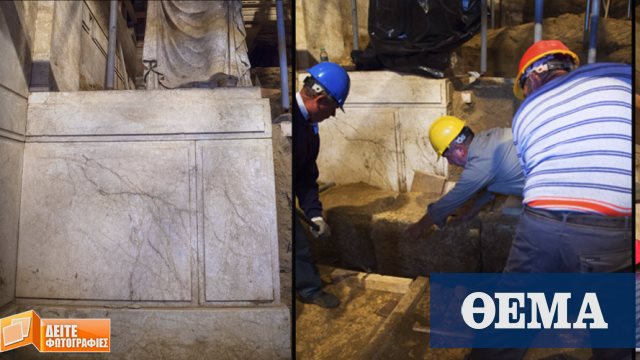

Comment